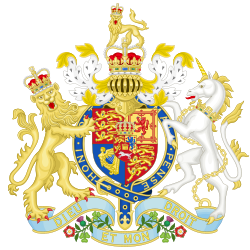Top Qs
Timeline
Chat
Perspective
Bank Restriction Act 1797
Act of the Parliament of Great Britain From Wikipedia, the free encyclopedia
Remove ads
The Bank Restriction Act 1797 (37 Geo. 3. c. 45) was an act of the Parliament of Great Britain which removed the requirement for the Bank of England to convert banknotes into gold. The period lasted until 1821, when convertibility was restored. The period between these two dates is known as the Restriction period.
Remove ads
Reasons for restricting
An increasing number of people were trading their banknotes for gold. The overprinting of banknotes caused the Bank of England to loose its supply of gold, and due to the gold standard, the value of each banknote was diminishing.[1] The timing of the act, which had been under consideration for a few months owing to runs on banks in Newcastle-upon-Tyne, Sunderland, and Durham that had in turn requested monetary support from the Bank of England,[2] was the invasion of Britain on 22–24 February 1797 by French forces in Fishguard. When news of this event, now known as the Battle of Fishguard, became known in London, a much greater run on the Bank of England was feared, had a large number of holders of banknotes attempted to convert them into gold when bullion reserves were heavily reduced. However, because the total face value of the notes in circulation was almost exactly twice the actual gold reserves held (£10,865,050 of notes, compared to £5,322,010 in bullion),[3] this would have bankrupted the Bank, and Parliament decided to suspend these "specie payments" with immediate effect; this suspension was renewed annually until 1821.[4]
Remove ads
Reasons for overprinting
British banknotes were overprinted by the government of William Pitt the Younger after Britain declared war on revolutionary France in 1793.[5] The Bank Restriction Act released the government from the fear of mass redemption of such convertible banknotes, and by the end of the war in 1814 the banknotes in circulation had a face value of £28.4 million, yet were backed by only £2.2 million of gold. However, by 1821, and with radical economic policies instigated by Sir Robert Peel (the future Prime Minister, acting as Chairman of the Bullion Committee), this situation was reversed, and with £2,295,360 of notes in circulation being backed by £11,233,390 of bullion,[3] the British government resumed "convertibility" on 1 May 1821 (two years ahead of schedule).
Remove ads
In popular culture

After the passing of the act, Richard Brinsley Sheridan publicly bemoaned the way in which the Bank of England had fallen under the influence of William Pitt the Younger by describing the institution as "An elderly lady in the City, of great credit and long standing who had unfortunately fallen into bad company". This in turn led to James Gillray’s famous cartoon entitled Political Ravishment; or the Old Lady of Threadneedle Street in Danger, which depicts Pitt seducing the Bank of England, personified as an old lady attired in £1 and £2 notes, for her fortune.[6] This cartoon is the origin of the Bank's nickname of "The Old Lady of Threadneedle Street", still in use today.
Subsequent developments
Summarize
Perspective
The act was amended and continued until the end of one month after the start of the next session of parliament by the Restrictions on Cash Payments Act 1797 (37 Geo. 3. c. 91).
The act was further amended and continued until one month after the conclusion of the present war by definitive treaty by the Restriction on Cash Payments (No. 2) Act 1797 (38 Geo. 3. c. 1).
The act was further continued, as amended, until 1 March 1803 by section 1 of the Continuance of Laws Act 1800 (39 & 40 Geo. 3. c. 17).
The act was further continued until 1 March 1803, as amended, by section 1 of the Restriction on Cash Payments Act 1802 (42 Geo. 3. c. 40).
The act was further amended and continued until 6 weeks after the start of the next session of parliament by the Restrictions on Cash Payments Act 1803 (43 Geo. 3. c. 18).
The act was further amended and continued until 6 months after the ratification of a definitive treaty of peace by the Restriction on Cash Payments Act 1803 (44 Geo. 3. c. 1).
The act was further continued, as amended, until 25 March 1815 by the Restriction on Cash Payments Act 1814 (54 Geo. 3. c. 99).
The act was further continued, as amended, until 5 July 1816 by the Restriction on Cash Payments Act 1815 (55 Geo. 3. c. 28).
The act was further continued, as amended, until 5 July 1818 by the Restriction on Cash Payments Act 1816 (56 Geo. 3. c. 28).
The act was further continued, as amended, until 5 July 1819 by the Restriction on Cash Payments Act 1818 (58 Geo. 3. c. 37).
The act was further continued, as amended, until the end of the present session of parliament by the Restriction on Cash Payments Act 1819 (59 Geo. 3. c. 23).
The whole act was repealed by section 1 of, and the schedule to, the Statute Law Revision Act 1871 (34 & 35 Vict. c. 116).
Remove ads
See also
Notes
Remove ads
References
Further reading
Wikiwand - on
Seamless Wikipedia browsing. On steroids.
Remove ads



